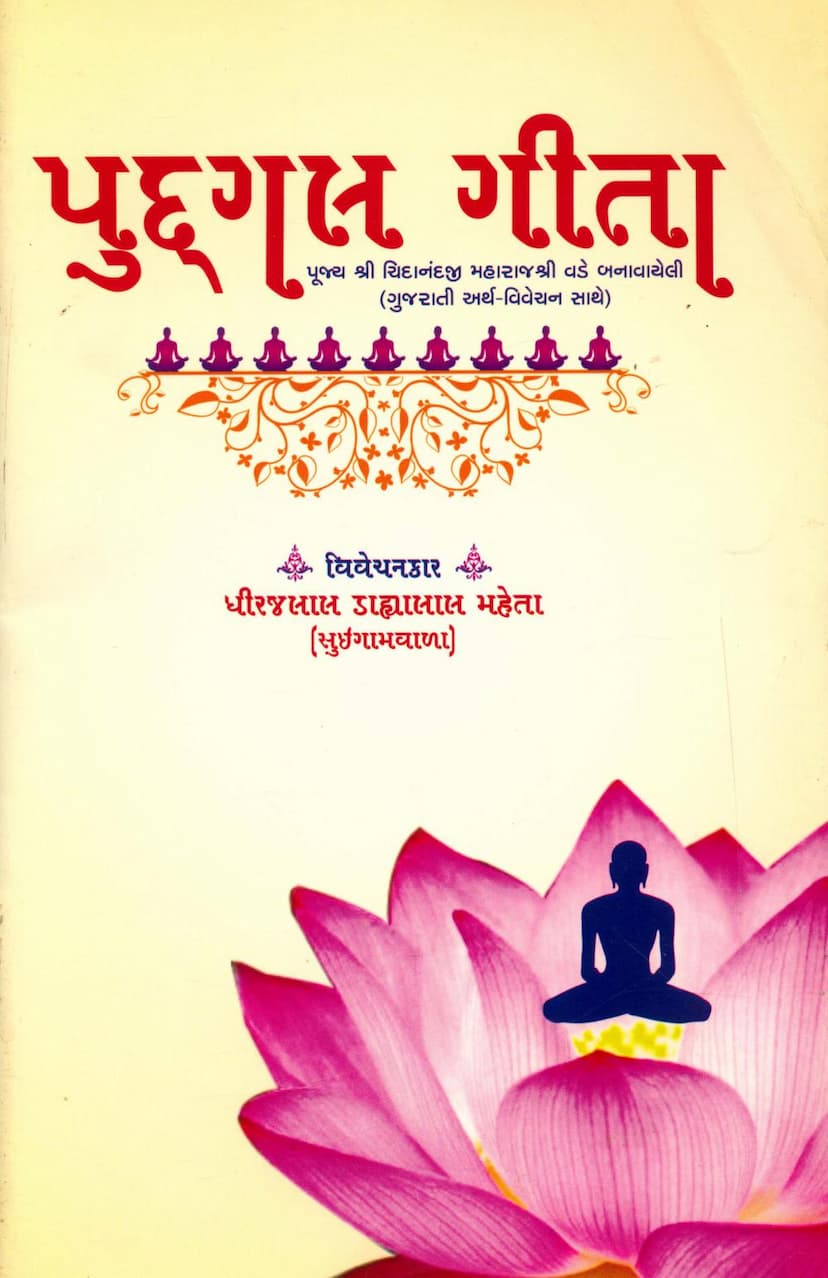Pudgal Gita
Added to library: September 2, 2025

Summary
Here's a comprehensive summary of the provided Jain text, "Pudgal Gita," authored by Pujya Shri Chidanandji Maharajshri, with commentary by Dhirajlal Dahyalal Mehta:
The "Pudgal Gita" is a Jain scripture that focuses on the nature of Pudgal (matter) and its relationship with the soul (Jiva). The text aims to disabuse the reader of attachment to material substances and guide them towards understanding the true nature of the soul.
Core Themes and Messages:
- Pudgal as the Source of Bondage: The Gita consistently emphasizes that all worldly experiences, joys, sorrows, and attachments stem from Pudgal. The body, its senses, material possessions, relationships, and even concepts like beauty, fragrance, taste, and touch are all manifestations of Pudgal.
- The Soul's True Nature: In contrast to Pudgal, the soul (Jiva) is described as formless, without color, smell, taste, or touch. It is pure consciousness and inherently free. The core message is to differentiate the soul from its material encasements and experiences.
- Disillusionment with Material Pursuits: The text systematically deconstructs the allure of Pudgal. It illustrates how all material things are impermanent, subject to change, decay, and destruction. Whether it's the body that ages and dies, wealth that is lost, or sensory pleasures that offer fleeting satisfaction, they all ultimately lead to suffering.
- The Illusion of Pudgal: The Gita uses various analogies to highlight the illusory nature of Pudgal and our attachment to it. Examples include comparing the attachment to Pudgal to a monkey clinging to a stick, or the futile desire to quench thirst with saltwater.
- The Path to Liberation: The ultimate goal presented is liberation (Moksha) from the cycle of birth and death, which is achieved by renouncing attachment to Pudgal. This involves:
- Understanding the Distinction: Deeply contemplating the difference between the soul and matter.
- Detachment (Vairagya): Cultivating a mindset of non-attachment towards all material things.
- Focus on the Self: Turning inward to realize the soul's inherent purity, bliss, and omniscience.
- Following the Teachings of the Arihants: Adhering to the wisdom of enlightened beings who have already achieved liberation.
- The Nature of Karma: The text implicitly connects attachment to Pudgal with the accumulation of karma, which binds the soul to the cycle of existence. Both merit (Punya) and demerit (Paap) are seen as forms of Pudgal that create bondage, albeit in different ways.
- The Impermanence of Worldly States: The Gita reiterates that states like youth, old age, wealth, power, and even sensory pleasures are temporary. The soul, however, is eternal and unchanging.
- The Importance of Right Knowledge and Conduct: The text implicitly advocates for the Jain principles of Right Faith (Samyak Darshan), Right Knowledge (Samyak Gyan), and Right Conduct (Samyak Charitra) as the means to overcome the illusion of Pudgal and attain liberation.
Structure and Content:
The "Pudgal Gita" is presented in a poetic, song-like format (Gita), with each verse (Gatha) offering a specific teaching or observation about Pudgal. The commentary by Dhirajlal Dahyalal Mehta provides explanations and elaborations on each verse, making the complex philosophical concepts accessible.
The verses cover a wide range of aspects related to Pudgal:
- Physical Form: Describing the body as made of Pudgal, with its colors, smells, tastes, and textures.
- Sensory Pleasures: Analyzing the temporary and ultimately unsatisfactory nature of pleasures derived from the senses.
- Material Possessions and Relationships: Highlighting their impermanence and the sorrow they bring when lost.
- The Cycle of Birth and Death: Explaining how attachment to Pudgal leads to transmigration through different life forms.
- The Virtues of Detachment: Praising those who live without worldly desires and maintain equanimity.
- The Role of the Soul: Emphasizing the soul's inherent nature and its potential for liberation.
Overall Purpose:
The "Pudgal Gita" serves as a profound spiritual guide for Jains, urging them to see through the ephemeral allure of the material world and to strive for the eternal bliss and liberation of the soul. It's a call to detachment, self-realization, and the unwavering pursuit of spiritual knowledge, aligning with the core teachings of Jainism.